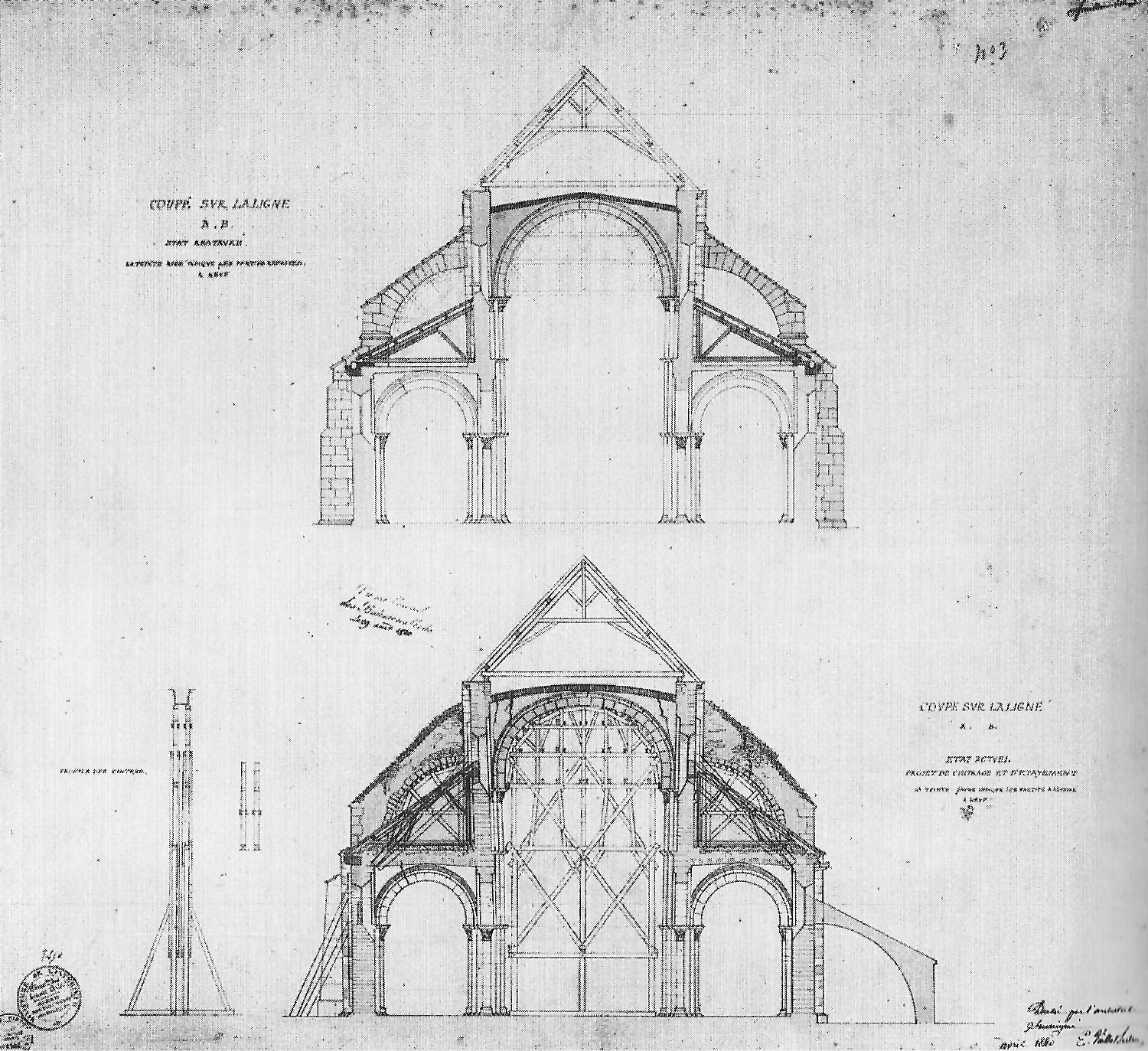Objects & Processes
Approaches to Architectural Identity
April 2014
Attempting to withstand the test of time is arguably one of the primary issues faced by all peoples of different cultures. The development of architecture has therefore become inevitably linked with the fear that human identity will become extinct and that nature will erase our ideas and our existence. (Owen, 2001, p. 16). This essay aims to examine how preserving identity through architecture has been addressed in different cultures, either as an object frozen in time, as seen within the French architectural tradition of Eugene-Emmanuel Viollet-le-Duc, or contrastingly, as a continuous process working within time and space, seen within examples of Japanese and Chinese traditions in architecture.
Eugene-Emmanuel Viollet-le-Duc, 1840, section drawings contrasting existing condition (below) and proposed restoration (above).
The embodiment of memory and identity within the physical structures of architecture is heavily entrenched within the European tradition, with John Ruskin professing that “We may live without her and worship without her, but we cannot remember without her” (Anderson, 1995, p. 23). This tradition of imbuing architecture with identity results from its historic presence and longevity, with Pierre Ryckmans commenting that with the rise and fall of each empire, buildings remained to “form an unbroken chain of architectural witnesses that perpetuate the memory of the past” (Ryckmans, 1989, p. 2) throughout the ancient cities of Europe. Driven by a desire to perpetuate the existence of these ancient buildings, Viollet-le-Duc believed that restoration was key, and that it was necessary “to reinstate it in a condition of completeness that could never have existed at any given time.” (Viollet-le-Duc, 1990, p. 269). This approach is seen in his restoration works to the Church of the Madeleine at Vézelay, France, which included removing parts of the original structural fabric in order to ensure the structure’s survival into the present day. (Murphy, 2000, p. 1). Despite this, the building is recognised as a work of Romanesque architecture, perpetuating Edward Ford’s commentary on European architecture as possessing “a kind of collective amnesia in which the modern replacement is treated as the original.” (Ford, 1997, p. 14). The creation of a memorable form appears to take precedence in Viollet-le-Duc’s work, allowing his idealisation to become identified as the original.
His second notable intervention was to the structure of Vézelay through the re-ordering and regularising of the nave arches and reconstruction of the flying buttresses. (Murphy, 2000, p. 103). His proposed restoration shows significant changes and draws some parallel as the architectural paradox of the Ship of Theseus, whereby “identity inheres in an objects continuing form, not in its fragmentary and ephemeral substances”. (Lowenthal, 1989, p. 68). In order to preserve form, changes were justified by Viollet-le-Duc to facilitate his own rationalist style and “an imagined stylistic completeness in the nave”. (Murphy, 2000, p. 144). His aspiration was to idealise the building into a static object, consolidating a fragmented ruin into architecture which was “exact and determinate”, rather than merely retain the existing structure as a disorganised “endless chain of mental imaginings”. (Forty, 2000, p. 211).
Shortly after completing work at Vézelay, Viollet-le-Duc was engaged to restore the prominent Cathédrale de Notre Dame de Paris. Here, he continued expressing his belief that a building manifested itself as an object possessing “knowledge of the True”, (Viollet-le-Duc, 1959, p. 7) implying that restoration did not seek to ‘restore’ a building, but to transform it into an object which projected the idealised ‘truth’ of history. This idealisation of Gothic architecture involved the replacement of more than sixty statues and inclusion of new gargoyles from Viollet-le-Duc’s own imagination, added because it provided a means of projecting the cornice and reduced the hard effect of the balustrade returns. (Reiff, 1971, p. 300). While clearly exhibiting a belief that “endurance in perpetuity is preservation’s guiding aim”, (Lowenthal, 1989, p. 68). Viollet-le-Duc removed “genuine thirteenth-century work”, reordering parts of the elevation into what he believed had “been there at the outset.” (Viollet-le-Duc, ed. Hearn, 1990, p.5) Such changes helped Viollet-le-Duc to disguise the erosion of time and captures “a particular historical moment”, (Forty, 2000, p. 212) representing architecture as an idealised object and thus, reinforcing the European tradition of possessing architecture which is static and withstands the passage of time.
Contrastingly, an alternative formation of cultural identity within architecture can be witnessed through the Ise Shrine in Japan. Having been in continual existence since 690 C.E., (Loo, 2010, p. 376) various changes and adjustments have occurred, ranging from “the placement and orientation of buildings, the number and dates of rituals, the number of shrines included, and some of the architectural details”. (Adams, 1998, p. 57) Arata Isozaki identifies how these changes show a “certain will to readjust the design towards a perceived authentic form” (Isozaki, 2006, p. 138) in a way which on the surface, finds some resonance with Viollet-le-Duc’s belief in an idealised restoration. At Ise however, because the emphasis is not on the shrine as static architecture but rather, a process of continual reconstruction, it becomes “the living embodiments of a deep past.” (Loo, 2010, p.376).
Eugene-Emmanuel Viollet-le-Duc, Plate XIV from Discourses on Architecture Volume 1,1889.
Procession of White Stone Placement Festival at Geku of Ise Shrine.
Naiku of Ise Shrine, Ise, Japan, 1993, western view of inner temple.
Isozaki’s further comments that, “in claiming to rehabilitate older forms, Ise has been significantly redesigned at crucial junctures” (Isozaki, 2006, p. 138), shows that preserving architecture as an object is not the primary goal at Ise. Instead, the use of timber, a highly perishable material has meant that the physical structure of Ise is not static but part of a constant process of replication which secures its immortality and forms the basis of its identity. (Isozaki, 2006, p. 138; Lowenthal, 1989, p. 73). In Cassandra Adams’ recount of the 1993 reconstruction ritual, she notes that while some physical changes have taken place, “the procedures followed today are very close to ancient conditions” with the only major difference being “the introduction of power tools.” (Adams, 1998, p. 57). This underlying principle for the reconstruction of Ise is therefore different from the European tradition because the architecture is not an inert object capturing a specific moment in time, but a continual process which interacts and changes with the passage of time.
Similarly, cultural identity for the Chinese was not imbued within the materials they used to build with and cities such as Suzhou were seen as urban fabrics which were physically free from time. (Mote, 1973, p. 51). For Ryckmans, the processes of reconstruction seen in pre-modern China represent an approach to architecture which believes that “eternity should not inhabit the building, it should inhabit the builder.” (Ryckmans, 1989, p. 4). A culture of reproduction and focus on techniques of construction rather than the object is present. Meaning is not necessarily carried with the architecture, but with the site and its history.
Indeed, this perception of space and time as process rather than static resonates within the techniques of Chinese art. In Xu Yang’s Qing Dynasty painting of Suzhou entitled Scenes of burgeoning life in the time of prosperity, a series of different facets are being represented simultaneously, indicating that the viewer is observing several events from different perspectival points. Various events occurring across the city are depicted individually and simultaneously, meaning that “there is no strict perspective, centred on a single point, but space is suggested by a sort of ‘progressive vision’.” (Burckhardt, 1967, p. 135). It can therefore be said that the painting is not a representation of a moment in history, but a series of experiences over a period of time in Suzhou. It captures “a past of the mind; its imperishable elements are moments of human experience” (Mote, 1973, p. 51) rather than a fixed and permanent moment.
Xu Yang, Scenes of Burgeoning Life in the Time of Prosperity, 1759, partial section of painting depicting civil servant examination (top left)and the ten thousand year bridge (centre).
F.W. Mote recounts the Great Pagoda of Suzhou as an example of architecture which has undergone multiple reconstructions, first built in the sixth century C.E. and subsequently reconstructed between the eleventh and twentieth centuries. (Mote, 1973, p. 50) This acceptance that rebuilding as the result of age or disaster represents what Ryckmans sees in Chinese architecture as “the transient nature of the construction is like an offering to the voracity of time.” (Ryckmans, 1989, p. 4). Viewing architecture as an ongoing process rather than as static followed Confucian teachings that “Only through the promise of transmission can human action hope to survive beyond a circumscribed present.” (Owen, 2001, p. 18) This clearly indicates that the physical presence of architecture is not necessarily imbued with cultural memory, and that Chinese history is not lodged in objects, (Mote, 1973, p. 51) but in writings and an understanding that construction processes work continuously with time.
The Chinese and Japanese developed an architectural tradition which accepted the passage of time, emphasising that identity is formed in an ongoing process operating within time and space. In France, Viollet-le-Duc’s restoration works highlighted the European tradition of protecting buildings against time as he endeavoured to create an idealised vision of how Romanesque and Gothic architecture should appear. Despite these diverging approaches to the formation of cultural identity through architecture, a consistent and unifying aim is present: a singular hope that the ideas these approaches represent eventually become an eternal part of the fabric of human cultural experience.
Reference List:
Adams, Cassandra. "Japan's Ise Shrine and Its Thirteen-Hundred-Year-Old Reconstruction Tradition." Journal of Architectural Education 52, no. 1 (1998): 49-60.
Anderson, Stanford. "Memory in Architecture." Daidalos 58 (December 1995): 22-37.
Burckhardt, Titus. "Landscape in Far Eastern Art." In Sacred Art in East and West Its Principles and Methods, 134-42. London: Perennial Books, 1967.
Ford, Edward. "The Theory and Practice of Impermanence: The Illusion of Durability." Harvard Design Magazine 3 (Fall 1997): 12 - 18.
Forty, Adrian. "Memory." In Words and Buildings: A Vocabulary of Modern Architecture, 206-19. London, England: Thames & Hudson, 2000.
Isozaki, Arata. Japan-Ness in Architecture. Cambridge, MA: The MIT Press, 2006.
Loo, Tze M. "Escaping Its Past: Recasting the Grand Shrine of Ise." Inter-Asia Cultural Studies 11, no. 3 (2010): 375-92.
Lowenthal, David. "Material Preservation and Its Alternatives." Perspecta 25 (1989): 66-77.
Mote, F.W. "A Millenium of Chinese Urban History: Form, Time, and Space Concepts in Soochow." Rice University Studies59, no. 4 (Fall 1973): 35-65.
Murphy, Kevin D. Memory and Modernity: Viollet-Le-Duc at Vézelay. University Park, PA: The Pennsylvania State University Press, 2000.
Owen, Stephen. "Lush Millet and a Stele: The Rememberer Remembered." In Remembrances: The Experience of the Past in Classical Chinese Literature, 16-32. Toronto: UT Bak-in-Print Service, 2001.
Reiff, Daniel D. "Viollet Le Duc and Historic Restoration: The West Portals of Nortre-Dame." Journal of the Society of Architectural Historians 30, no. 1 (March 1971): 17-30.
Ryckmans, Pierre. "The Chinese Attitude Towards the Past." Papers on Far Eastern History 39 (March 1989): 1-16.
Viollet-le-Duc, Eugene-Emmanuel. "Defining the Nature of Restoration: Readings and Commentary." In The Architectrual Theory of Viollet-Le-Duc, edited by M.F. Hearn, 269-88. Cambridge, MA: MIT Press, 1990.
———. Discourses on Architecture Volume 1. Translated by Benjamin Bucknall. London: George Allen & Unwin Ltd., 1959.
———. "Viollet-Le-Duc: A Visionary among the Gargoyles." In The Architectural Theory of Viollet-Le-Duc, edited by M.F. Hearn, 1-19. Cambridge, MA: MIT Press, 1990.






